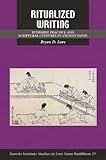Ritualized Writing : Buddhist Practice and Scriptural Cultures in Ancient Japan / Bryan D. Lowe; ed. by Robert E. Buswell.
Material type: TextSeries: Kuroda Studies in East Asian Buddhism ; 27Publisher: Honolulu : University of Hawaii Press, [2017]Copyright date: ©2017Description: 1 online resource (352 p.) : 11 b&w illustrationsContent type:
TextSeries: Kuroda Studies in East Asian Buddhism ; 27Publisher: Honolulu : University of Hawaii Press, [2017]Copyright date: ©2017Description: 1 online resource (352 p.) : 11 b&w illustrationsContent type: - 9780824859404
- 9780824859435
- 294.3/820952 23
- BQ1136.C6 L69 2017
- online - DeGruyter
- Issued also in print.
| Item type | Current library | Call number | URL | Status | Notes | Barcode | |
|---|---|---|---|---|---|---|---|
 eBook
eBook
|
Biblioteca "Angelicum" Pont. Univ. S.Tommaso d'Aquino Nuvola online | online - DeGruyter (Browse shelf(Opens below)) | Online access | Not for loan (Accesso limitato) | Accesso per gli utenti autorizzati / Access for authorized users | (dgr)9780824859435 |
Frontmatter -- Contents -- Acknowledgments -- Abbreviations -- Conventions -- Introduction -- Part One. Ritual Practices -- 1. Merit, Purity, and Ceremony -- 2. Ritual Compositions -- Part Two. Organizations -- 3. Writing Societies -- 4. Instituting Transcription -- Part Three. Microhistories -- 5. Disciplinary Regimes -- 6. Haunted by Demons, Watched by Kings -- Epilogue -- Appendix: Names of the Kōmyōshi/Tōdaiji Scriptorium -- Bibliography -- Index -- About the Author
restricted access online access with authorization star
http://purl.org/coar/access_right/c_16ec
Ritualized Writing takes readers into the fascinating world of Japanese Buddhist manuscript cultures. Using archival sources that have received scant attention in English, primarily documents from an eighth-century Japanese scriptorium and colophons from sutra manuscripts, Bryan D. Lowe uncovers the ways in which the transcription of Buddhist scripture was a highly ritualized endeavor. He takes a ground-level approach by emphasizing the activities and beliefs of a wide range of individuals, including scribes, provincial patrons, and royals, to reassess the meaning of scripture and reevaluate scholarly narratives of Japanese Buddhist history.Copying scripture is a central Buddhist practice and one that thrived in East Asia. Despite this, there are no other books dedicated to the topic. This work demonstrates that patrons and scribes treated sutras differently from other modes of writing. Scribes purified their bodies prior to transcription. Patrons held dedicatory ceremonies on days of abstinence, when prayers were pronounced and sutras were recited. Transcribing sutras helped scribes and patrons alike realize this- and other-worldly ambitions and cultivate themselves in accord with Buddhist norms. Sutra copying thus functioned as a form of ritualized writing, a strategic practice that set apart scripture as uniquely efficacious and venerable. Lowe employs this notion of ritualized writing to challenge historical narratives about ancient Japan (late seventh through early ninth centuries), a period when sutra copying flourished. He contends that Buddhist practice fulfilled a variety of social, political, and spiritual roles beyond ideological justification. Moreover, he demonstrates the inadequacy of state-folk dichotomies for understanding the social groups, institutions, and individual beliefs and practices of ancient Japanese Buddhism, highlighting instead common organizations across social class and using models that reveal shared concerns among believers from diverse social backgrounds.Ritualized Writing makes broader contributions to the study of ritual and scripture by introducing the notion of scriptural cultures, an analytic tool that denotes a series of dynamic relationships and practices involving texts that have been strategically set apart or ritualized. Scripture, Lowe concludes, is at once a category created by humans and a body of texts that transforms individuals and social organizations who come into contact with it.
Issued also in print.
Mode of access: Internet via World Wide Web.
In English.
Description based on online resource; title from PDF title page (publisher's Web site, viewed 02. Mrz 2022)


